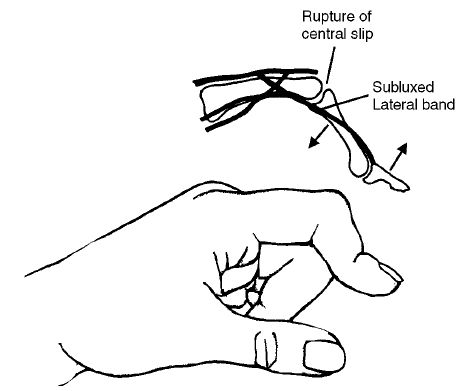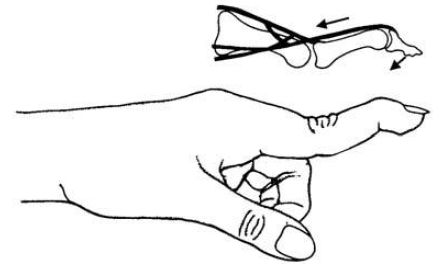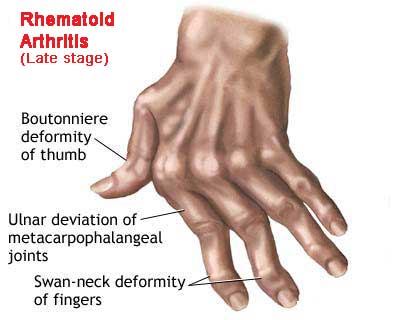RHEUMATOID ARTHRITIS-HAND DEFORMITIES
SUMMARY
1. Boutonniere deformity: due to rupture of the portion of the extensor hood over the PIPJ. Rx: Boutonnière ring splint.

2. Swan neck deformity: due to synovitis at the MCP, PIP, or DIP (rare) joint. Rx: Swan neck ring splint orthosis.

3. Ulnar deviation: weakening of the extensor carpi ulnaris, ulnar, and radial collateral ligaments, wrist deviates radially. Rx: ulnar deviation splint.

4. Flexor tenosynovitis: diffuse swelling of the flexor tendon sheaths.
5. Floating ulnar head: synovitis at the ulnar styloid leads to rupture or destruction of the ulnar collateral ligament, which results in laxity of the radioulnar joint. The ulnar head "floats up" dorsally in the wrist.
6. Pseudo-benediction sign: Stretched radioulnar ligaments allow the ulna to drift upward. Extensor tendons of the fourth and fifth digit are subject to abrasion from rubbing on the sharp, elevated ulnar styloid and can rupture.
7. Z-deformity: radial deviation at the wrist, ulnar deviation of the digits, and often, palmar subluxation of the proximal phalanges.
8. Hitchhiker's thumb: similar mechanism to Z-deformity of the thumb.
Image: MD, S. (2015). Physical Medicine and Rehabilitation Board Review, Third Edition. 3rd ed. New York: Demos Medical Publishing, p.104-107.
Reference(s)
Wilkinson, I., Furmedge, D. and Sinharay, R. (2017). Oxford handbook of clinical medicine. Oxford: Oxford University Press. Get it on Amazon.
Feather, A., Randall, D. and Waterhouse, M. (2020). Kumar And Clark’s Clinical Medicine. 10th ed. S.L.: Elsevier Health Sciences. Get it on Amazon.
Hannaman, R. A., Bullock, L., Hatchell, C. A., & Yoffe, M. (2016). Internal medicine review core curriculum, 2017-2018. CO Springs, CO: MedStudy.
Therapeutic Guidelines. Melbourne: Therapeutic Guidelines Limited. https://www.tg.org.au [Accessed 2021].